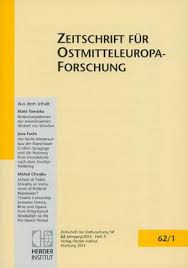Eindeutige Bilder, komplexe Identitäten. Imperiale, nationale, regionale Identitätskonzepte und ihre Visualisierung auf der galizischen Allgemeinen Landesausstellung in Lemberg 1894
Unambiguous images – complex identities. Imperial, regional, and national identities and their visualisation at the Galician Land Exhibition in Lemberg 1894
Author(s): Anna Veronika WendlandSubject(s): Cultural history, Communication studies, Political history, 19th Century, Identity of Collectives
Published by: Verlag Herder-Institut
Keywords: Unambiguous images; complex identities; identities and their visualisation; Galician Land Exhibition in Lemberg 1894;
Summary/Abstract: The Land Exhibition of 1894 in Lemberg (Lviv/Lwów) was a multi-medial social and political event in fin de siècle Galicia. Different interest groups from political and corporate backgrounds used the exhibition to communicate their vision of development and prosperity for imperial Austria’s Eastern borderland. To achieve this goal, a broad variety of recent and traditional media techniques was used. Inter-acting images, texts, artefacts, press coverage, polemical publications, and performative elements produced a highly persuasive range of communication. Austrian imperial, Galician regional, and national identities were communicated and competed with each other in this field. Which one prevailed, or which one was displayed in combination or co-existence with others, depended on the particular circumstances at any one time (e.g. the Emperor’s visit to Lviv, or patriotic gatherings of different background, or leisure). The Poles, who politically dominated the Crownland, discovered the genre of historical battle panoramas, and transformed an important Polish lieu de mémoire, the Kościuszko uprising of 1794, into a tourist attraction, the Racławice Panorama on the Exhibition grounds. Polish gentry and state functionaries organised mass trips of peasants and schoolchildren (both Polish and Ukrainian/Ruthenian) as patriotic pilgrimages. In presenting Polish industry, commerce, and agrarian production from all regions of partitioned Poland and even from the Polish communities in the Americas, Poles tried to convey the image of a modern, united Polish nation. The Ukrainians (Ruthenians), the non-dominant nation in Galicia, sought to highlight their ancient East Slavic roots in Eastern Galicia, and focused their attempts on a presentation of indigenous Ruthenian traditional culture in an Ethnographic exhibition which technically was on an advanced European level. Ukrainian activists chose this strategy in order to underscore their claims for social emancipation and fair representation in Galicia’s political bodies. This self-folklorization strategy was very successful – the Ethnographic exhibition being one of the most frequented parts of the Land exhibition. However, the traditionalist concept of Ukrainian culture was in stark contrast to social reality, as Galician Ukrainian society had been rapidly modernizing and mobilizing since 1848. The Polish and Ukrainian national movements intended to set the agenda by producing unambiguous messages and evoking emotions, but they were often not able to gain full control over the images they produced, and the creation of social identities. As evidence on (peasant) visitors shows, many Galicians used the Exhibition in their own ways which had not been anticipated by patriotic organisers – first of all as a place for leisure and holiday, and also for consumption: of goods, food, news, sensations, and new media forms.
Journal: Zeitschrift für Ostmitteleuropa-Forschung
- Issue Year: 58/2009
- Issue No: 1-2
- Page Range: 111-161
- Page Count: 51
- Language: German

